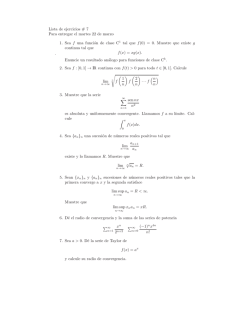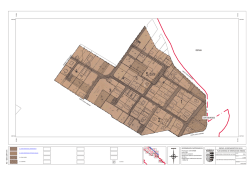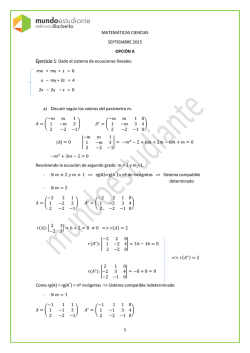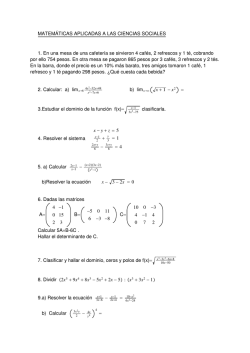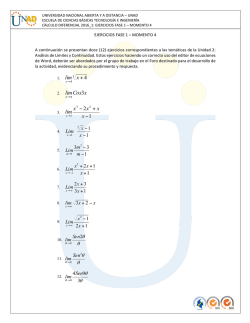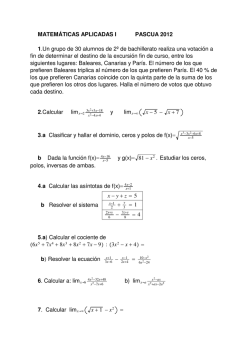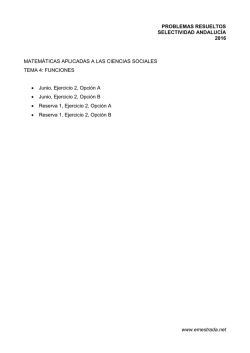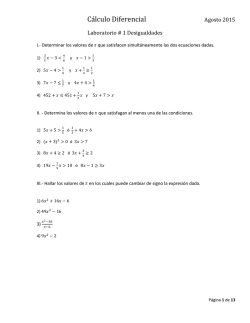
Soluciones - yoquieroaprobar.es
Soluciones
1. a) AL(x) = 4 ⋅ (x ⋅ 3x) = 12x 2 cm2
c) V (x) = x 2 ⋅ 3x = 3x 2 cm3
d) AL(5) = 12 ⋅ 52 = 300 cm2, AT (5) = 14 ⋅ 52 = 350 cm2, V (5) = 3 ⋅ 53 = 375 cm3
b) AT (x) = 2x 2 + 12x 2 + 14x 2 cm2
2. a) f (56) =
56
= 28
2
b) f (101) =
101 + 1
= 51
2
c) (f o f o f)(422) = f(f(f(422))) = f(f(211)) = f(106) = 53
d) La función f es no creciente, luego el mayor valor se obtiene para x = 128 y el menor para x = 50. Se calcula:
(f o f o f o f o f o f o f)(128) = f(f(f(f(f(f(f(128))))))) = f(f(f(f(f(f(64)))))) = ... = f(f(4)) = f(2) = 1
(f o f o f o f o f o f o f)(50) = f(f(f(f(f(f(f(50))))))) = f(f(f(f(f(f(25)))))) = f(f(f(f(f(13))))) = ... = f(f(2)) = f(1) = 1
Luego la función es (f o f o f o f o f o f o f)(x) = 1 constantemente en 50 x 128.
⎪⎧
8 ⎪⎫ ⎛
8⎤
c) D(h) = {x ∈ R / 8 − 3x 0} = ⎪⎨ x ∈R/ x ⎪⎬ = ⎜⎜⎜−∞, ⎥
⎪⎪⎩
⎪
⎜
3 ⎪⎭ ⎝
3 ⎥⎦
2
b) D(g) = {x ∈ R/x − x − 2 ≠ 0} = (−∞, −1) ∪ (−1, 2) ∪ (2, +∞) d) D(k) = {x ∈ R / sen x 0} = [2kπ, (2k + 1)π] ∀k ∈ Z
3. a) D(f) = R = (−∞, +∞)
4. a) (f + g)(−1) = f(−1) + g(−1) = (−3) + 1 = −2
b) (h ⋅ f)(4) = h (4) ⋅ f(4) = 2 ⋅ 12 = 24
3
x 3 + 4 x 2 − 4 x − 13
=
x +4
x +4
f) (f + g)(x) = f(x) + g(x) = (x 2 − 4) +
g) (g ⋅ f)(x) = g(x) ⋅ f(x) =
3 x 2 − 12
x+4
⎛ 1⎞ 1
15
3
c) (f o g)(2) = f(g (2)) = f ⎜⎜⎜ ⎟⎟⎟ = − 4 = −
h) (g o f)(x) = g(f(x)) = g(x 2 − 4) = 2
⎜⎝ 2 ⎟⎠ 4
4
x
d) (g o h)(9) = g (h (9)) = g(3) =
e) (h o f)(3) =
i) (f o h)(x) = f(h(x)) = f ( x ) = x − 4
3
7
5
5. Dominio: D = [0, 4]. Recorrido: R = [1, 4].
Y
1
O 1
Y 2f (x)
Y
1
O 1
1
O 1
Y
Y
f (x+2)
f (–x)
2+f (x)
X
–f (x)
X
1
O 1
X
1
O 1
X
X
3
5
3
5
6. Raíces: x1 = 1, x2 = 5 ⇒ f(x) = a(x − 1)(x − 5). Pasa por (0, 3) ⇒ 3 = 5a ⇒ a = . Por tanto, f (x) = x 2 −
7. a) 4 b) 2,4 c) 2,02 d)
f (1 + h) − f (1)
(1 + h)2 − 1
h 2 + 2h
=
=
= 2+h
(1 + h) − 1
h
h
8. Dominio: D = [−6, 4]. Recorrido: R = [−2, 2].
x 2 = |x| ≠ g(x) = x
b) 0, porque 0 <
1
O 1
−2 x − 10
≠ g(x) =
x −2
2
<1
3
⎛ x 2 − 1⎟⎞
⎟⎟ = lim ( x − 1)( x + 1) = lim( x + 1) = 2
⎟⎠
x →1⎜
x →1
x →1
x
−
1
( x − 1))
⎝
11. a) lim ⎜⎜⎜
⎛ x 2 + 3 x + 2 ⎞⎟
⎟⎟ = lim ( x + 1) = 1
b) lim ⎜⎜⎜
2
⎟⎠
x →−2 ⎜
x →−2 ( x − 2)
4
x
−
4
⎝
X
−2 x − 10
x −2
pues D(f) = [−5, 2) ≠ D(g) = ∅.
c) e
⎛ x 2 − 1⎞⎟
⎟⎟ = −1 = −∞
d) lim+ ⎜⎜⎜
⎟⎠
x →0 ⎜
x
0+
⎝
x →2
Evaluación
d)
e
⎛ x − 3 ⎞⎟
x − 3
⎟⎟ = lim
c) lim ⎜⎜⎜
⎟
x →3 ⎜
x →3 (
⎟
x
−
3
⎝
⎠
x − 3 )( x +
12. lim− f ( x ) = lim+ f ( x ) = f ( x ) ⇒ 8 = k − 10 ⇒ k = 18
x →2
f (1 + h) − f (1)
= lim(2 + h) = 2
h→0
(1 + h) − 1
⎛ x + 3 ⎞⎟
⎟⎟ = g(x) = log(x + 3) − log(2 − x)
c) f(x) = log⎜⎜⎜
⎜⎝ 2 − x ⎟⎠
b) f(x) = x 2 − x − 2 = g(x) = (x + 1)(x − 2) d) f (x) =
10. a) +∞
h→0
Y
Máx. relativos: M1(−2, 2) y M2(2, 2).
Mín. relativos: m1(−6, −2), m2(0, 0) y m3(6, −2).
Crecimiento: (−6, −2) ∪ (0, 2).
Decrecimiento: (−2, 0) ∪ (2, 6).
9. a) f(x) =
e) lim
18
x +3
5
23
3)
=
1
2 3
© Copyright 2024
